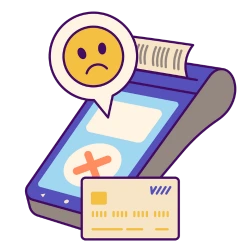As a merchant who accepts credit cards, it’s likely you’ll come across decline code 51 at some point. When this happens, it doesn’t mean you can’t complete the sale. Understanding credit card decline codes and what they mean will help you find potential solutions. In turn, this understanding will save your business from losing important sales.
Possible Reasons You’re Receiving Decline Code 51
If you receive a decline 51 response on a transaction, it’s pretty straightforward. It’s not a general error and means the cardholder does not have the funds to complete the transaction.
Credit cards have a credit limit that purchases cannot exceed. For example, let’s say a customer has a credit card with a limit of $1,000, and they’ve used $975 of their limit. If the customer uses their card to pay for a $50 transaction at your business, you’ll receive the decline code 51 response. The same is true for debit cards and the balance in a customer’s bank account. If the purchase amount exceeds the checking account balance, you will be presented with a decline code 51 message.
It’s important to note merchants should not attempt to process the transaction again. Unfortunately, this could increase the likelihood of forcing a chargeback or overdraft charge on the cardholder.
What is a Decline Code?

When you process a credit card, sometimes the transaction is declined. When this happens, it’s not because there is something wrong with your machine or software. The card-issuing bank is the one responsible for these declines.
Decline codes are short numbers that provide merchants with a bit more information on the reason behind declining a transaction. Typically, payment processors provide their merchants with a decline code guide with their terminals. The credit card declined code 51 is one of the most common responses a merchant receives.
Decline code 51 is the processing response for insufficient funds or an exceeded credit limit. When you get this decline code, it’s not a good idea to try to process the card again without voice authorization. This could put you at risk of a chargeback for invalid authorization when processing a card after a declined code 51.
How to Resolve Your Credit Card Decline Code 51
The best way to handle a declined card scenario is to ask the customer to use a different card or method of payment. They may also contact their card issuing bank to clear up the matter directly. Typically, you can find the issuer’s phone number on the back of the customer’s credit card. Since the decline message is on behalf of the cardholder, the only thing you can do is suggest another form of payment or have the customer come back at a later date.
It’s important to note that decline code 51 is unique to the cardholder, so there should be no issues with subsequent transactions. Most consumers have more than one method of payment and should have no problem completing the transaction.




